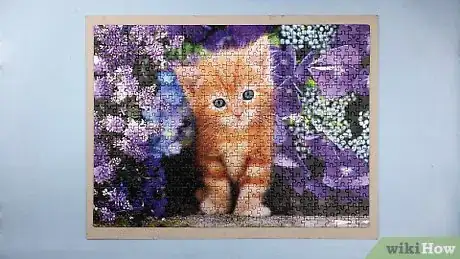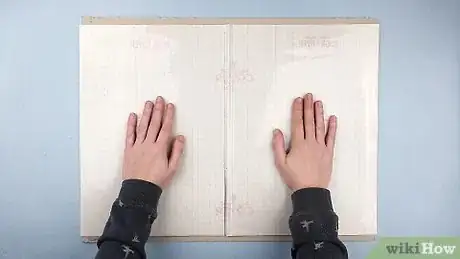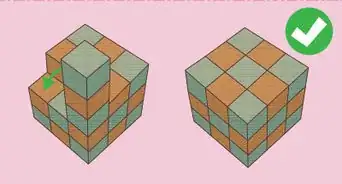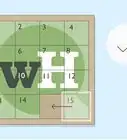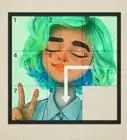This article was co-authored by wikiHow staff writer, Jessica Gibson. Jessica Gibson is a Writer and Editor who's been with wikiHow since 2014. After completing a year of art studies at the Emily Carr University in Vancouver, she graduated from Columbia College with a BA in History. Jessica also completed an MA in History from The University of Oregon in 2013.
This article has been viewed 21,307 times.
Learn more...
You've just spent hours putting together a puzzle and you know you want to display it, but how do you do it? While gluing puzzles is common, glue is messy, takes a long time to dry, and can leave a haze on the puzzle. If you want a faster way to preserve your work, laminate the puzzle with adhesive sheets or a roll of clear contact paper. We'll walk you through how to use both products so you can enjoy your puzzle for years to come!
Steps
Using Adhesive Laminating Sheets
-
1Slide a thin piece of cardboard under your puzzle if you didn't use a mat. Since you'll be laminating the back of the puzzle, you have to be able to flip it over. If you did the puzzle on top of a puzzle mat, just leave it on the mat.
- Use cardboard or poster board that's at least as large as the puzzle so you don't lose any pieces when you flip the puzzle over.
- Laminating just the back of the puzzle should provide enough stability to hold the pieces in place. However, if you'll be moving the puzzle around a lot or you just want extra piece of mind, it's completely fine to laminate the front, too.
-
2Place cardboard on top of the puzzle and carefully flip the puzzle over. Get another piece of thin cardboard or poster board and lay it on the puzzle. Then, firmly grip both pieces of cardboard and flip them over. Remove the top piece of cardboard so the back of the puzzle is visible—this is what you'll apply the laminate sheets to.[1]
- Although this is easy to do with a small puzzle, you may want an extra set of hands if you're flipping a large puzzle.
- It's fine to leave the puzzle on the other piece of cardboard while you're working.
Advertisement -
3Arrange laminate sheets on the puzzle so they cover the entire surface. You can buy adhesive puzzle kit sheets at craft or hobby stores, or search for adhesive laminate sheets online. Most of these are square in size so you can arrange the squares in a grid on the back of the puzzle. Just don't take off the backing from the adhesive sheets just yet.[2]
- It's okay if the sheets overlap by any amount, but they shouldn't go past the edges of the puzzle.
-
4Peel off the adhesive backing and press the sheets onto the puzzle. Most laminate sheets have a rectangular strip at one end. Peel off this small rectangle and press it along the edge of your puzzle. Ensure that the sheets don't stick out from the sides of the puzzle. Then, peel off the rest of the backing and slowly press the sheet in place. Repeat this with your other sheets of the laminate so the whole puzzle is covered.[3]
- Although you could peel off all of the backing before you press the sheet onto the puzzle, it's harder to perfectly line up the sticky sheet and you're more likely to get bubbles or creases.
-
5Press against the surface to smooth out any air bubbles. Some kits come with a small plastic squeegee tool that you can drag across the puzzle to ensure the sheets lay flat. If you don't have one, use a rolling pin instead. Roll it over any spots that have air bubbles or creases.[4]
- Your puzzle is now laminated! You can hang it or frame it to display in your home.
- Since you lined up the edges of the sheets, there's no excess to trim.
Laminating a Puzzle with Contact Paper
-
1Flip the puzzle upside down so the back faces up. You'll be laminating the back so the front of the puzzle won't have contact paper clouding the surface. If you didn't complete the puzzle on a mat or piece of poster board, slide a thin piece of poster board or cardboard under the puzzle. Then, lay another piece on top of the puzzle and grip both layers with your hands. Carefully flip the poster board over and remove the top piece of the poster board, so the puzzle is now upside down.
-
2Roll contact paper onto the puzzle and trace the puzzle's outline. Place the edge of the contact paper roll at a corner edge of your puzzle so both sides line up perfectly. Unroll the contact paper until it reaches the other end of the puzzle, but don't peel off the adhesive backing yet. Then, use a pen to mark this spot.[5]
- If your contact paper isn't wide enough to cover the whole puzzle, you'll need to cut 2 sheets and overlap them. Plan on overlapping them by 1⁄2 inch (1.3 cm).
-
3Use scissors to cut the contact paper to size. For accuracy, lay a ruler down where you made the mark on the contact paper. Then, trace a guideline and cut along the line with a pair of scissors. Don't peel away the backing from the contact paper just yet.[6]
- If you have to use two or more pieces of contact paper, cut out all of the pieces you need.
-
4Peel back a corner of the contact paper and press it onto a puzzle corner. Although you can peel off all of the backing, you'll have more control if you peel away just a few inches of backing from the corner. Peel back just a corner of the contact paper and line it up with a corner of the puzzle before you press it down.
-
5Peel away the backing and press the contact paper to the puzzle. Press down firmly as you unroll the paper so it's completely smooth on the surface of the puzzle. Look for any air bubbles in the contact paper and push down on them. You can use a rolling pin, the palms of your hands, or the flat bottom of a glass to smooth the surface.[7]
- Now you're all set to display your work! Hang it on the wall with foam stickers or place the puzzle in a frame for a really polished display.
Things You’ll Need
Using Adhesive Laminating Sheets
- 2 thin pieces of cardboard or poster board
- Rolling pin
- Adhesive laminating sheets
Laminating a Puzzle with Contact Paper
- Puzzle mat or poster board
- Scissors
- Contact paper
- Rolling pin
References
- ↑ https://youtu.be/Mp25yB9iex8?t=460
- ↑ https://youtu.be/jnPM6LXIDfI?t=58
- ↑ https://youtu.be/odbKHTbFoN8?t=114
- ↑ https://youtu.be/Mp25yB9iex8?t=536
- ↑ https://www.puzzlewarehouse.com/blog/2015/01/14/how-to-temporary-mounting-for-puzzles-step-1-contact-paper/
- ↑ https://www.puzzlewarehouse.com/blog/2015/01/14/how-to-temporary-mounting-for-puzzles-step-1-contact-paper/
- ↑ https://www.puzzlewarehouse.com/blog/2015/01/14/how-to-temporary-mounting-for-puzzles-step-1-contact-paper/
